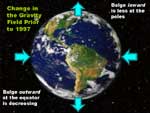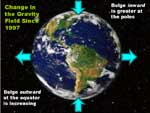Archived Articles
Two Scientists Have Detected A Large-Scale Redistribution
Of Mass Within The Earth System, Beginning in 1998!
Introduction
The Hutton Commentaries (THC) has been saying from the beginning that a shift in the poles of Earth's rotational axis can only be caused by a significant shift of mass somewhere within our planet. Now, two scientists studying data on Earth's gravity field have found evidence of just such a mass shift that began in 1998. This is the year in which Cayce readings 3976-15 and 378-16 said that a forty-year-long period, from 1958-1998, marking the beginning of predicted Earth changes would come to an end. Then, in 1998 and beyond there would be “the changes wrought in the upheavals and the shifting of the poles.”
We present evidence here that the “upheavals” may have begun in the inner Earth between 1998 and 2002, where the liquid outer core meets the overlying plastic mantle. This is the core-mantle boundary, or CMB. Upheavals along the CMB may have been detected by means of precision satellite-ranging measurements conducted since 1979. Interpretations of the voluminous measurements between 1979 and 2002 have been published by two scientists, Christopher Cox and Benjamin Chao, in the August 2 issue of Science magazine (p. 832). Here follows their reasoning and their conclusions.
The Measurements
Earth's equatorial diameter is about 27 miles longer than its polar diameter. This slight pumpkin-like shape results from axial rotation and large-scale mantle convection. (See Figure 1).
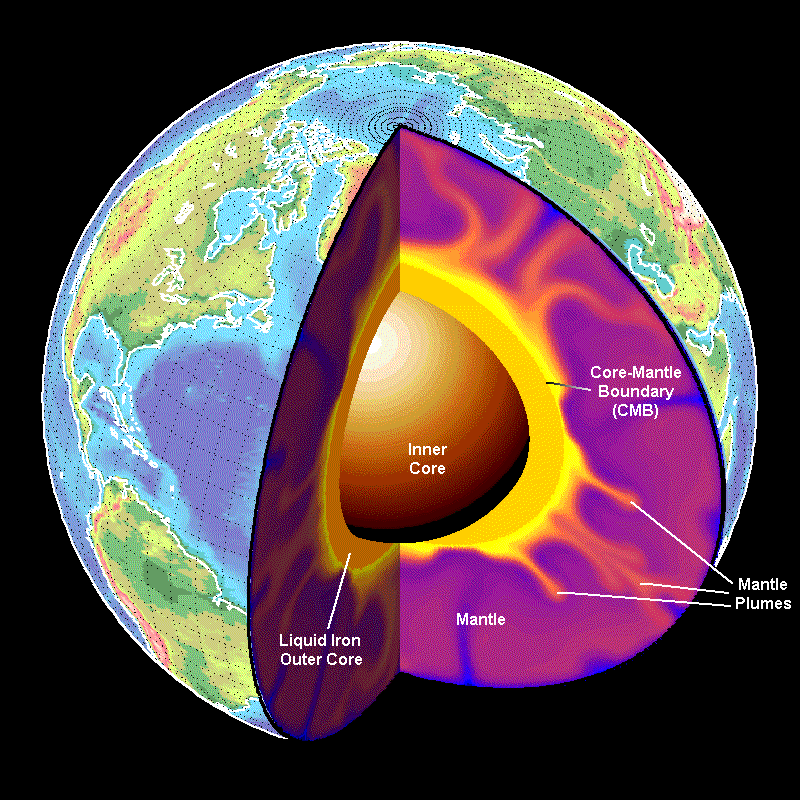 Figure 1. A view of Earth's interior showing features referred to in the text.
Figure 1. A view of Earth's interior showing features referred to in the text. This so-called “dynamic oblateness” (symbol J2) can be measured by laser-ranging techniques to show increases or decreases over time. If J2 decreases over time, then scientists infer that mass must have been redistributed from equatorial regions to higher latitudes. (Relative to the size of the Earth, however, any such mass distribution is assumed to be quite small). If J2 increases over time, Earth's mass may be inferred to have moved from the polar regions toward the equator.
Observed Changes In J2
An explanation of the major aspects of the Cox and Chao results was published at the same time in Science, in the Perspectives section by A. Cazenave and R. Nerem (p. 783-784). They wrote:
“Changes in J2 were first measured 20 years ago by Yoder et al., who used satellite laser ranging to show that it was decreasing linearly by 3 X 10-11 per year. Several investigators later confirmed his observations. Changes in J2 with time have now been monitored for more than 25 years with satellite laser ranging. Cox and Chao show that, contrary to expectation, in recent years, J2 has started to increase.
“The earlier decreasing trend in J2 meant that Earth was becoming less oblate. This observation can be largely explained by postglacial rebound - the viscous relaxation of Earth's mantle that began when polar ice caps started to melt at the end of the last glaciation 18,000 years ago. Postglacial rebound still continues today. Seasonal oscillations of J2 have also been observed. They are caused by the redistribution of air mass in the atmosphere and of water mass among the atmosphere, oceans, and continental water reservoirs.
“....For most of the past two decades, J2 has been steadily decreasing. But in early 1998 it suddenly started to increase substantially, indicating a large-scale mass redistribution from high latitudes to the equatorial regions.”
Possible Causes Of The Change
What caused this change? Cox and Chao considered several possibilities. Two potential candidates remained: large-scale movements in the oceans, and mass transport in Earth's fluid outer core (see Figure 1).
Motions of the ocean that can affect J2 are difficult to analyze with present modeling precision. The strong El Nino event that occurred in late 1997 to early 1998, however, might have produced sufficient meridional mass transport of ocean waters to affect J2, although the authors seems skeptical. As for the role of Earth's outer core, Cox and Chao say:
“Judging from the large magnitude and relatively rapid evolution of the observed J2 changes, one possible cause could be net material flow driven by the geodynamo in the fluid outer core and along the core-mantle boundary. There is evidence of a substantial geomagnetic jerk in 1999. Such jerks have been associated with flow acceleration in the top of the core, in addition to long-term magnetic dipole changes. Could they be related? To date, no correlation has been demonstrated between the geomagnetic observations and the observed J2 . However, a review of geodynamo simulation results indicates that the core models can possibly explain J2 changes ....depending on the modeling assumptions.”
Overlooked by Cox and Chao is the seminal work of Woods Hole geophysicist, Carl Bowen on the mass anomaly structure of the Earth. As presented in our review article, “Gravity of Inner-Earth Upheavals,” Bowin has postulated that very large mass anomalies lie deep in the Earth, “explained, as a first approximation, by topography at the core-mantle boundary.” Furthermore, relief at the CMB consists of masses that are perhaps 100 times greater in magnitude than those of Earth's principal surface features, like island arcs, mid-ocean ridges, and the Azores-high area. Thus, movements of these masses along the CMB can have a profound effect on Earth's spin-axis stability.
Is The Geodynamo Cause of The J2 Anomaly Related To Pole Shift,
As Evidenced By Chandler's Wobble Between 1998 And 2000?
If the discovery of the J2 anomaly is to have any significance as a precursor of pole shift, its signal ought to show up in some component of the wobble of Earth's axis (Chandler's wobble). We looked for such evidence and here is what we found:
By examining the motion of the Chandler's wobble for the period between January 1996 and December 2000, it appears that during December 1998 the normal, relatively smooth motion of the wobble path is abruptly deflected; and it takes about 20 months to recover and resume its normal wobble path. This anomaly can be seen in the following graphic.
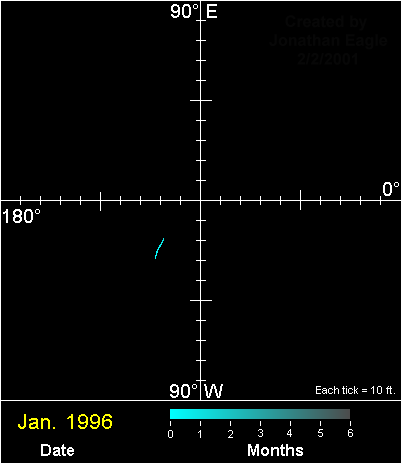 Figure 2. An animated graphic showing the actual motion of the Earth's axis relative to the North Pole (90° N) which is represented by the intersection of the axes. Note the anomalous behavior of the wobble starting in December 1998.
Figure 2. An animated graphic showing the actual motion of the Earth's axis relative to the North Pole (90° N) which is represented by the intersection of the axes. Note the anomalous behavior of the wobble starting in December 1998.By decomposing the circular motion of the pole into X and Y components the anomalous characteristics can be more easily seen.
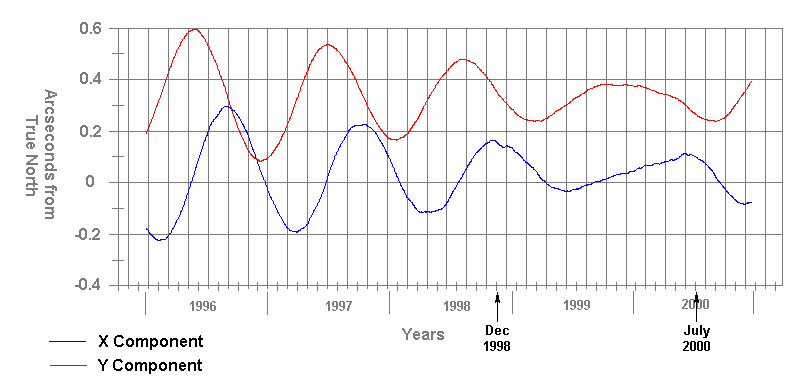 Figure 3. Graph showing the X and Y components of the Chandler wobble during same period of time as Figure 2.
Figure 3. Graph showing the X and Y components of the Chandler wobble during same period of time as Figure 2. Probing For Convergences Between Geophysical Events
And Readings Predictions
Is it possible that there might be a true correlation between Earth's surface geological events, the Chandler wobble anomaly, mass movements at the CMB, the post-1998 "upheavals", torrid-area volcano eruptions of readings 376-16 and 3976-15, and the great mass transfer of 1998 - 2001 detected by Cox and Chao?
Reading 378-16 states that the record chambers containing the history of Atlantis would be opened only “when there was the returning of those into materiality, or to the Earth's experience, when the change was imminent in the Earth; which change, we see, begins in '58 and ends with the changes wrought in the upheavals and the shifting of the poles....” Consider, then, that these upheavals may have begun, in a modest way, in 1999.
During October 1998 -- October 1999 Hutton noticed an extremely unusual cluster of 17 light earthquakes (M4.5-4.9) and 23 moderate quakes (M5.0-5.5) that occurred in the high Arctic, north of Severnaya Zemlya, centered approximately at 85.7N and 81.4E. This cluster has now been tied to submarine volcanism in the Arctic by German researchers. C. Müller and W. Jokat (EOS, June 13, 2000, p. 265). Theymeasured more than 200 earthquakes between January and August, 1999, that originated along the submerged Gakkel Ridge. They state that, "The detection of this earthquake swarm and the evidence for its volcanic origin is the first direct evidence of recent volcanic activity in the high Arctic," that is, of upheavals in a portion of the northern polar region close to the North Pole. This may coincide, whether by coincidence or not, with the Cox-and-Chao-identified movement of mass from the Earth's equatorial region toward the polar regions.
As for further possible 1999-2000 surface geophysical expressions of the mass shift detected in 1998-2001 consider this. Three significant earthquakes that seem to fit the "upheavals" mentioned in 378-16 occurred during the December 1998--July 2000 interval shown on Figure 2. Northwest Turkey was shaken by an M7.4 earthquake on August 17, 1999. The magnitude of the tremor tied that of the 1912 Turkey temblor for the strongest quake of the last century in that country. Horizontal offsets along various segments of the North Anatolian Fault approached 16 feet and vertical upthrusts of up to seven feet were noted. Perhaps 20,000 people were killed and considerable earthquake damage occurred in Istanbul. Then, on November 12, 1999, an M7.1 quake occurred 70 miles east of the August shock, on the same fault, producing additional vertical crustal changes.
Finally, on September 21, 1999, the largest earthquake of the last century in Taiwan struck near Chi-Chi. Extensive surface ruptures occurred along 53 miles of the Chelungpu fault. A maximum horizontal displacement of 32 feet was among the largest fault displacements ever measured in modern earthquakes. The Tachia River was cut by a 25-foot vertical upheaval that created a new waterfall.
Reading 3976-15, once again, states that "there will be the upheavals in the Arctic and in the Antarctic that will make for the eruption of volcanoes in the torrid areas, and there will be a shifting then of the poles.."
Also beginning in 1999, there seems to have been a significant increase in the eruption of torrid-zone volcanoes, such as Galeras (3/99), Poas (late '99), Arenal (10/99), Mt. Cameroon (6/99), Taal (9/30/99), Telica (8/11/99).
In 2000, many more erupted: Rabaul (early 2000), Fuego (7/26/00), Pacaya (3/2/00), Colima (11/4/00), San Cristobal (2/28/00), Popocatepetl (4/18/00), Mayon (2/28/00), Soufriere Hills, Montserrat (3/20/00), Nyamuragira, (1/31/00), and Guagua Pichincha and Tungrahua (both 4/18/00).
Lastly, note that the broader interval of mass motion identified by Cox and Chao (early 1998 through 2001) begins with the great antarctic Balleny Sea earthquake (M 8.2). The interval also encompasses the intense series of strong, major (M7.2 and M7.8) and great (M8.0 and M8.1) quakes in the New Britain, New Ireland, and eastern Papua New Guinea region of November 16 and 17, 2000. And finally, we must note two other prodigious quakes: 1) the January 26, 2001, M7.7 reverse-fault upheaval in the Kachchh region of India (felt over an area more than 16 times that of the M7.8 1906 San Francisco earthquake), and 2) the great (M8.1) earthquake in southern Peru on June 23, 2001.
Conclusion
Predictions of post-1998 upheavals and torrid-area volcanic eruptions in two readings seem to be occurring in a modest way. If more significant upheavals commence we may expect shortly thereafter the shifting of the poles. Pole shift will lead to significant Earth changes worldwide, many of which are described in various Cayce readings. Whether or not these recent geophysical activities correlate with the large scale reorganization of Earth's mass field noted by Cox and Chao, or with Chandler's wobble anomalies related to mass movements at the core-mantle boundary, requires further evidence to prove. What is tantalizingly clear, however, is that measurable changes in Earth's mass distribution -- that may be precursors of larger motions leading directly to pole shift -- did in fact begin to occur almost exactly as predicted, around 1998.

